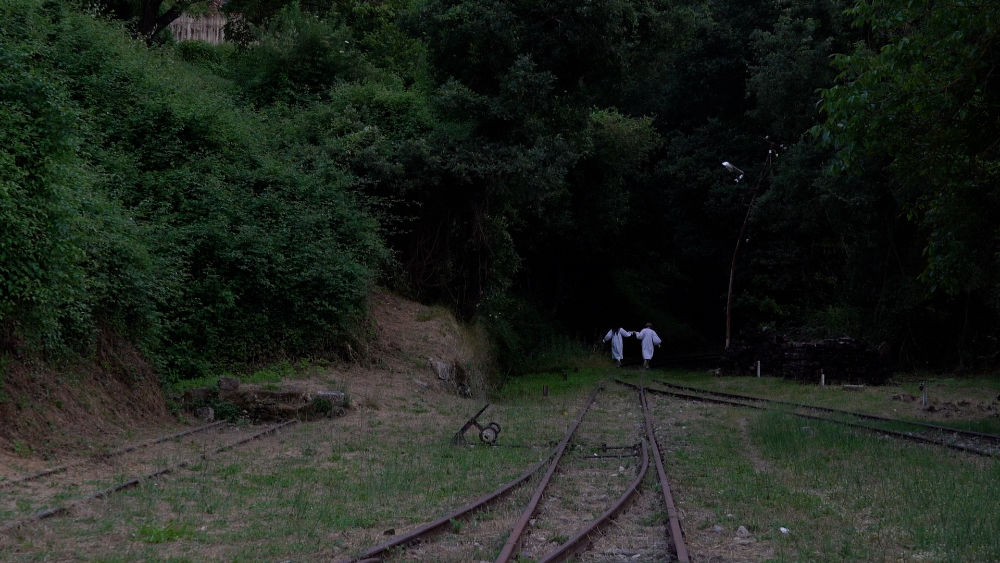
Selected for AFI '25 by GAMeC, Bergamo, Italy.

What compels you to work with moving image, and when did you first become interested in the medium?
I’ve a background in psychoanalysis, junghian and Gestalt therapy. As a child filming has always been my passion. Cinema has been historically related to the understanding of the psyche. I did my MA in moving image at Goldsmith as I intended image-making as a background methodology to construct my spacial installation. I work with images and text as base for its, I’ve always intended my installation as film stills, settings for activations, through audio or actions. During the pandemic I felt the urge to start making with the medium again as materialisation of space, time, experiences. I am interested in challenging time and the hegemony of narratives with a beg and an end. My methodology is to work with intuitive thinking, personifications of mythological characters and archetypes, mixed with personal experiences to challenge perception of time as more of an archive of intuitions than the one of a linear story, in relation also to contemporary technology and the way we construct memories through digital experiences nowadays.
Can you speak about the potential that dreaming and altered states of reality offer individuals and societies? How do you feel this is reflected in filmmaking and in your artwork specifically?
I have always been interested in the common Greek origin of two words: mania and mantis. A state of alteration is connected to the ability of divination, or even: the latter stems from the first. In a moment of history in which it is more than palpable the failure of the system we have relied upon for our individual and societal development, I think it is necessary to focus on alternative forms of production and circulation of knowledge and to try to explore their potential. In my films I try to question linear narratives and to de-compose and re-compose memories, actions, visions, images as a complex ecosystem that can trigger new ways of understanding of life and death, time and space, spirituality and the relationship between real and surreal.
Please share a list of books, music, films, artworks, thinkers, spaces and places that inspire your practice, and in particular have fed into your thinking around this film.
I would like to mention three main references for my film: Antonio Gramsci, the Sardinian born intellectual and politician, not only for the huge impact that his thinking has on contemporaneity, but also because it is in his ‘Letters from prison’ that I have encountered for the first time the Gongilo, a small reptile that is central to Serpentina, symbol of renewal and rebirth connected with the cult of the Mother Goddess, widely developed in Sardinia since the Neolithic era. Starting with such an investigation of a primordial female cult, I discovered the Janas, Sardinian female mythological figures who lived in domus de janas, stone tombs whose walls were often adorned with magical and auspicious symbols. Their name echoes that of the janare, witches of the rural tradition of the Naples area, my hometown. Benevolent creatures, they spent their days weaving with golden threads. Their activity of weaving immediately evoked Maria Lai, a Sardinian artist known for her textile works and for the seminal ‘Legarsi alla Montagna’ developed in the small Sardinian town of Ulassai and among the most celebrated relational art events. I thus approached the Su Marmuri textile cooperative, which has long collaborated with Maria Lai, to produce the textile that appears in the performance recorder in the film. The last reference is Chris Marker’s La Jetée, quoted in the first frame of my film. The use of a temporal paradox in La Jetée, to assess that ‘there’s no escape out of time’ nurtured my idea of an a-temporal museum of natural science as a container for diachronic encounters can take place and where reality escapes a taxonomic cataloguing and exists in imagination, intuition and mytholology.
What new projects or lines of research are currently preoccupying you?
I am currently working on an expansion of my installation Tentacular Bed, commissioned by Sharjah Art Foundation for the 16th edition of the Biennial. Tentacular Bed is a sculptural platform in the form of an oversized, modular and transportable bed that can host different formations, of humans, animals, objects and activities. Some of its parts are equipped with musical strings and the audience is welcomed to activate them by ‘playing’ them. The installation is in reference to an imaginary geography related to the primordial Tethys Ocean, that imaginatively reconnect my hometown Naples to Delos, a sacred island in the Cyclades archipelago, outlining the shape of the bed, that resembles that of a bicaudate siren. I am working on writing a score for the sculptures/music instruments, in order to collectively activate them in different sessions of work. Through the songs and personification of mythological characters there will be the composition of a narrative for a new film, part of my research project WARP.
The ethos of Tentacular Bed, pertaining to an alternative geography of the Mediterranean envisioned as a liminal and non-border space in which transformations can occur and a-temporal and nonlinear narratives circulate, would find a new body in the soundscape and the film to be produced in the next year.


© 2025 www.crawfordartgallery.ie